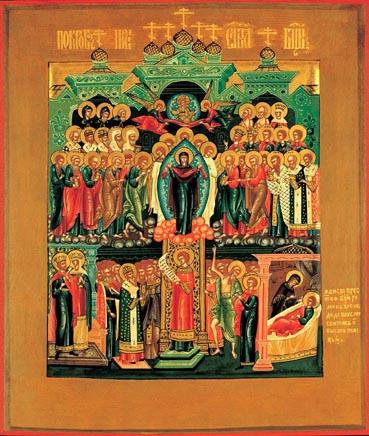Theotokos of Vladimir and the Virgin Pokrov
The Theotokos of Vladimir
is one of the original seven icons painted by St. Luke. In 450 it was transferred to Constantinople and in the early 12th century sent to Grand Duke Yuri of Kiev as a gift by the the Patriarch Luke. When being moved in 1155, the horses refused to leave the city of Vladimir and this was taken as a
sign that the Virgin wanted the icon there.
The icon was brought to Moscow in 1395 and is credited with saving the city from Tamerlane. This was repeated in Tartar invasions of 1451 and 1480 and the Poles in 1621. The icon never returned to Vladimir.
Unique among sacred icons, it reportedly took an airplane flight around Moscow at the
behest of Joseph Stalin during World War II. Within days, the German army unexpectedly started retreating. The Christ Child hugs his mother's neck as the Virgin gazes outwardly with a look that reflects the icon's first name: tenderness.

The veneration of the Virgin Pokrov
is traced to Constantinople in 911. A pagan Russian fleet threatened Constantinople and the faithful gathered in the darkness of October 1 to pray in the Blachernae Church. St. Andrew the Fool for Christ and St. Epiphanius saw a vision of a weeping Blessed Virgin
descend from the dome into the Church and kneel and pray with those gathered. She then stood and spread her gleaming veil over those present as a sign of protection. The city was protected against the Kievan Rus' invasion (as it had been earlier in 860).
Ironically, the Feast of the Protection (Pokrov) of the Mother of God was first celebrated in 12th century Russia. In addition to the Virgin and saints in the icon, St. Andrew appears center right pointing to the vision.



|